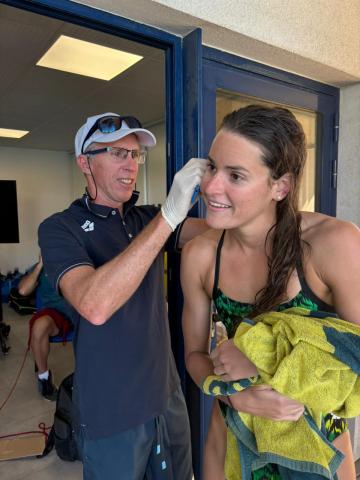by Dr Greg Cox
If an Olympic swimmer’s body is their engine, I could tell you the best fuel they need to generate the power to succeed.
I’ve just returned from three weeks with the Australian Dolphins in a training camp in Canet En-Rosselin, France, and I can share some of the secrets of what high-performing sportspeople eat.
Swimming has a high physiological load – swimmers typically undertake high volume, strenuous daily training including swimming and dry-land (gym and conditioning).

On high training days where athletes undertake 2-3 training sessions a day, calorie requirements can be as high as 6,000-8,000 per day, depending on the volume and intensity of daily training.
Carbohydrate is the primary fuel for high intensity swim training.
Swimmers now need to develop the skills to adjust their food and fluid intakes to align their daily carbohydrate intake with their daily fuelling requirements.
These swimmers also need to consume adequate protein and a wide range of fruit and vegetables, as well as healthy fats (i.e. avocado, nuts, seeds and olive oil) to support health and well-being.
The Dolphins trained 1-3 times a day and typically start early morning.
Most swimmers, particularly for hard morning sessions, will have an easy-to-eat, cereal-based “first” breakfast.
In France we started training a little later (6:30am-7:00am), so first breakfasts were scheduled around 5:30am-6:00am.
Following their first swim session some athletes hit the gym before walking back to their accommodation for their “second” breakfast.
These athletes are all responsible for catering their own breakfasts and lunches, so the clear message was do what you typically do at home.
This second breakfast may, for some, consist of eggs and vegies on toast with a fruit smoothie. For others it could be a cereal top-up with yoghurt and fruit.
It's common for swimmers to sneak in a short nap before lunch which could include a couple of wraps or leftovers with fruit and yoghurt.
Some swimmers don’t tolerate a heavy meal at lunch, particularly if they have a hard afternoon training session scheduled a couple of hours later.
Following afternoon training our Dolphins headed off to dinner where an Aussie chef on-site prepared a range of meals.
These varied nightly including Veal Cotoletta, Grilled Chicken and Prawns with roasted baby potatoes, Risotto Milanese, and a variety of salads and fresh fruit.
Many of the swimmers have unique pre-race routines, including certain foods.
A favourite of the camp saw many Dolphins choose a pasta meal the night before a heavy day of racing.
Caffeine is widely consumed so it wasn’t any surprise to see the Aussie coffee machine heavily used.
Caffeine is allowed in sport and can enhance exercise performance.
But it’s not the most important ingredient to high-level success and shouldn’t be the cornerstone nutrition strategy for any athlete.
Caffeine is known to interrupt your sleep. So, even at the top level, planning is important particularly over multiple days of racing.
This was my first trip away with the Australian Dolphins, although I have travelled extensively with other sports domestically and internationally since 1998.
I have supported athletes across seven Olympic cycles and attended three Olympics as performance support personnel.
In 2016 I was the Nutrition Lead for the Australian team at the Rio Olympics.
A lesson for young athletes is you need to know the food environment you create is highly influential on what you choose to eat.
So, families and support teams can support an athlete to make food and fluid choices which align with training.
Many of the Dolphins I met were particularly good at planning around quality training sets, so it’s a good lesson to learn - come prepared for these sessions to ensure you can train your best.
Sports nutrition over the years has become more individualised and aligned to changes in training, environment and athlete progression.
We also work in coordinated performance teams connected into coaches and athletes, and this provides a clearer understanding of nutrition and performance.
An important learning, and one often overlooked, is that it is training that drives changes in an athlete’s physique aligned to their sport.
Swimmers, while all different, look like swimmers, because they do a lot of swimming – it's not because they all eat the same.
The role of nutrition is simply to support an athlete to undertake that training.
Greg Cox is a Fellow of Sports Dietitians Australia, and co-Head of the Program for Nutrition and Dietetics at Bond University.